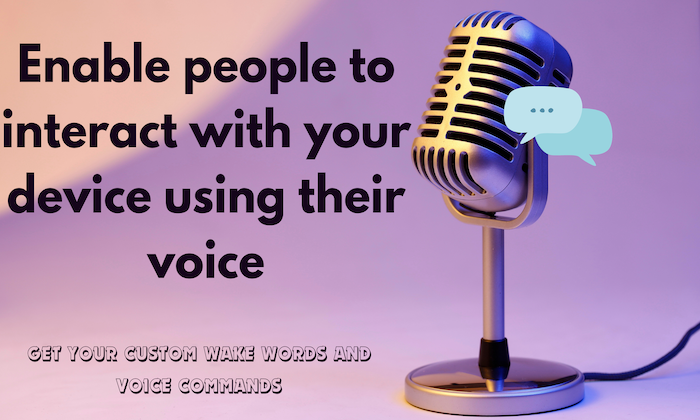What are voice triggers and how are they used?
Voice Recognition
Smart Devices
Voice Commands
Quick Answer:
Voice triggers, also known as wake words, are specific phrases like “Hey Siri,” “OK Google,” or “Alexa” that activate a device's voice recognition system. They enable hands-free interaction, making technologies like smart home systems, automotive assistants, and healthcare devices more accessible, efficient, and user-centric.
What Are Voice Triggers?
Voice triggers are short, predefined phrases that signal a device to start listening for voice commands. They function as the gateway between passive hardware and active user interaction, eliminating the need for touch or manual input.
These phrases are foundational to products such as voice assistants, smart TVs, wearables, and in-car infotainment systems.
Why Wake Words Matter for Voice AI
Wake words are essential for enabling intuitive and efficient voice-first experiences. Their design and performance directly impact user satisfaction and technology adoption.
Core Benefits
- Hands-free convenience: Critical for multitasking, accessibility, and safety
- Efficiency: Reduces interaction latency compared to screen or button-based input
- User engagement: A smooth activation experience increases adoption and trust in voice-enabled products
Building Blocks of a Voice Trigger System
Developing a voice trigger system involves a lightweight yet precise audio processing pipeline:
- Keyword spotting engine: Detects predefined phrases using CNN or RNN-based models
- Feature extraction: Uses Mel-frequency cepstral coefficients (MFCCs) or log-Mel spectrograms to isolate key acoustic features
- Wake word classification: Matches the trigger phrase to a pre-trained model, either via one-shot or few-shot detection techniques
- NLP pipeline: Post-activation, the system processes user intent using NLP to execute the corresponding action
Where Voice Triggers Are Used
Voice triggers are embedded in diverse environments to enable quick, reliable activation:
- Smart home devices: Control lights, appliances, and security systems using simple voice prompts
- Automotive systems: Enable navigation, calls, and music control with phrases like “Hey BMW,” enhancing driver safety
- Healthcare: Allow clinicians to retrieve information or interact with systems hands-free, preserving hygiene
- Consumer electronics: Used in smartphones, wearables, and headsets to enable low-friction control
Challenges and Data-Driven Solutions
Despite their importance, voice triggers present engineering and UX challenges:
Common Challenges
- Ambient noise interference
- Accent and dialect variation
- False positives or missed activations
- Privacy and data security concerns
Best Practices
- Use diverse training data: Including varied accents, age ranges, and noise conditions improves model robustness
- Update models regularly: Refining with real-world feedback minimizes detection drift
- Educate users: Clear communication improves correct usage and satisfaction
FutureBeeAI’s Datasets and Tools
FutureBeeAI offers multilingual keyword-spotting datasets built for production-grade voice AI systems. With over 100 supported languages, our datasets enable you to reduce false triggers, improve accuracy, and deploy globally.
Technical Highlights:
- Audio format: WAV, 16 kHz, 16-bit, mono
- Balanced metadata: Includes speaker age, gender, accent, and recording scenario.
Case Study: A European automotive brand reduced false rejections by 25% using FutureBeeAI’s German-dialect dataset subset.
Leveraging the YUGO Platform
The YUGO platform enables scalable and structured speech data collection with end-to-end workflow control.
Platform Capabilities
- Remote contributor onboarding
- Guided prompts and quality checkpoints
- Integrated 2-layer QA validation
- Metadata tagging and re-recording support
YUGO ensures clean, bias-aware, and deployment-ready datasets for training and fine-tuning keyword detection models.
Conclusion
Voice triggers are the first impression users have of your voice assistant or smart product. Building them accurately requires diverse training data, fine-tuned models, and continuous validation.
FutureBeeAI helps you develop wake word systems that are fast, inclusive, and field-ready. From OTS datasets to fully customized solutions, our team supports every stage of your model lifecycle.
Ready to optimize your voice-trigger pipeline? Get in touch to start your next project with precision.
FAQ
How do voice triggers differ from voice commands?
Voice triggers activate the listening mode of a device. Voice commands follow the trigger and represent the user’s instruction (e.g., “Play music”).
What Else Do People Ask?
Related AI Articles
Browse Matching Datasets
Acquiring high-quality AI datasets has never been easier!!!
Get in touch with our AI data expert now!


-data-collection/thumbnails/card-thumbnail/top-resources-to-gather-speech-data-for-speech-recognition-model-building.webp)





